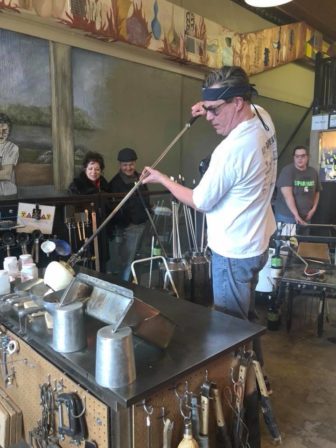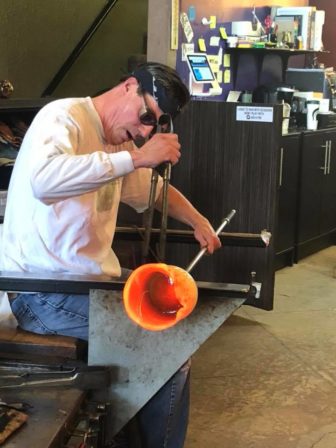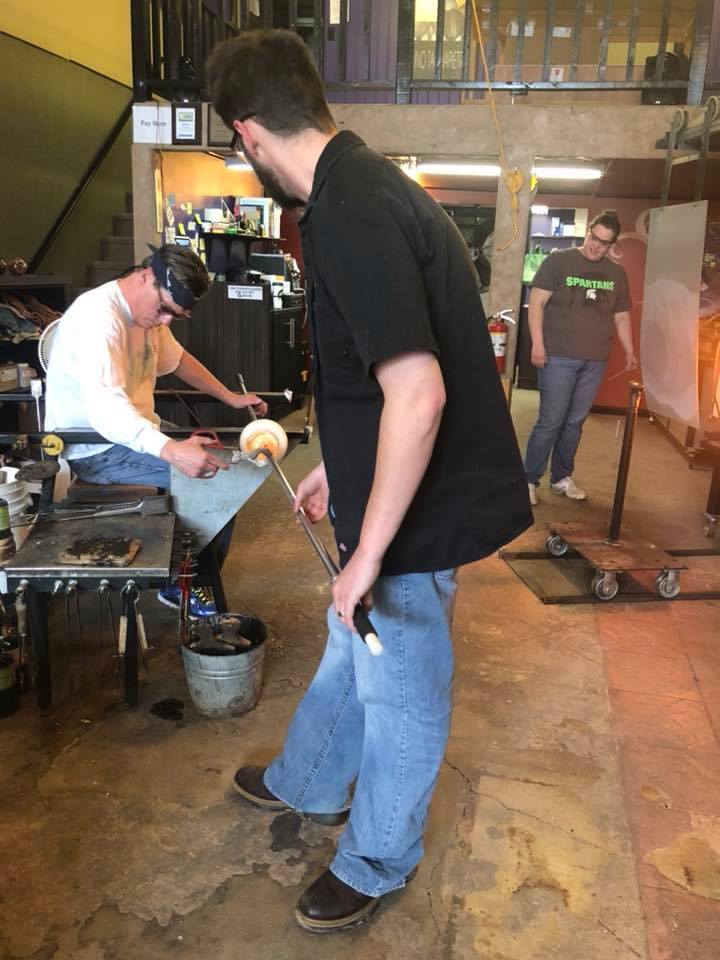With the frigid temperatures and snow-covered streets, one might step inside Williamston’s Fireworks Glass Studios out of curiosity, or to warm up. When they first walk inside, they will still feel the cold wind outside because the studio leaves the front door propped open. When they walk deeper into the studio, the temperature increases and they might even break a sweat.

Debbie Behrendt and her husband were out having lunch when they strolled past Fireworks Glass Studios. They walked in out of curiosity. Photo by Kayleigh Garrison.
Lining the counter are dozens of hand-crafted glass art. Behind the counter are the people and machines that make them.
With the machines’ temperatures averaging between 900 and 2,100 degrees, sometimes reaching as high as 2,500, it’s normal for someone to fan themselves or remove their jacket while inside Fireworks Glass Studios.
Despite the hot environment and high risk of getting burned, glass artist Rhonda Baker wasn’t afraid when owner Dave Porter opened the furnace door and exposed her to 2,100 degrees of heat for the first time.
“Dave brought me to that furnace and he goes, ‘Are you afraid of it?’ I go, ‘It’s hot, but I’m not afraid.’ He told me to come back on Monday and he didn’t really know anything else about me,” Baker said. “The rest is history.”
Ten years later, Baker comes to the studio every day feeling as eager as she was when she first started.
“The designs you can make are endless,” Baker said. “What I love about this job is that I have the freedom to be anything I want to be. In a bigger factory, they make the same thing over and over again with the exact same colors. Here, we are free to be artists and not craftsmen.”
Porter founded Fireworks Glass Studios in 2006. When he opened the studio, he had been blowing glass since he was 12 years old. He decided to open this studio to “explore my passion for hot glass every day.”
“My goal every day is to learn something new about glass, and to create pieces filled with passion and insight into the properties of glass,” Porter said in an email. “I hope to create a place where beautiful glass [is] made long after I am no longer capable of doing so. I want it to be a place of wonder, creativity and equipped to provide glass [artists] with all of the equipment they could possibly need.”
The glass art made in the studio is on display throughout the store and can be purchased. While the glass artists have made custom pieces in the past, Baker said they primarily make art based off things that inspire them. Each glass artist is inspired by something different, whether that be mythology, nature, the colors in the sky, a carpet pattern or even a box of cereal.
“We all approach things from a different perspective, and this allows us to blend ideas and come up with new creations,” Porter said.
Baker said the most difficult part about her job is coming up with new ideas. When she’s not feeling inspired, she feeds off the other glass artists’ inspiration.
“When we work in a studio like we do, I think we inspire each other all the time,” Baker said. “When one slacks off, there’s four others to come up and say, ‘OK! It’s my turn. I got this idea,’ and then we just go with that.”
When the glass artists aren’t working on pieces to sell in the studio, they are helping out Steven Bezinque, a renter who has been a glass artist for roughly 15 years.
When Bezinque isn’t working as a full-time pediatric radiologist, he rents a space at Fireworks Glass Studios so he can “fool around.”

Glass artist Steven Bezinque said that creating things is one of the most basic human needs. Photo by Kayleigh Garrison.
“I sit at a little computer screen all day long—a stressful job where I can’t make any mistakes, so I try to come here about twice a month or so,” Bezinque said. “I’m not really good at it. There’s always more to learn; there’s always things to improve.”
Although he enjoys blowing glass, Bezinque has no plans of doing this as a full-time job.
“Then it would be work—I just get to play,” Bezinque said. “I have a job and this is my hobby; this is what I do for fun. It’s really hard to make it as an artist. I’m thrilled if I can break even selling these things. I just sell them to clear up shelf space in my house.”
At Fireworks Glass Studios, most glass artists start out as apprentices. They don’t get paid and perform various tasks like sweep floors and sell art. Along the way, they learn how to blow glass.
“I did a year apprenticeship and then I’ve been working for two years,” glass artist Tekla Balmer said. “I live down the block and I worked at a bar across the street, so I had to walk past the studio every day, and I just thought it was cool and finally mustered some courage and came in and swept floors and they showed me how to do it.”
Like the other glass artists who work at Fireworks Glass Studios, Balmer learned everything on the job.
“It was literally coming in and sweeping the floors, doing the dirty work and taking the 20 minutes a day that I was given to learn,” Balmer said.
Although working at a glass studio wasn’t necessarily on her radar, Balmer keeps coming back because it helps her relieve stress and relax.
“The fact that when you have something 1,000 degrees in your lap, you literally can’t think of anything else,” Balmer said. “Any of the worries in the world that you have—gone. Yeah, it’s hot and it’s dangerous, but that’s the exciting part behind it.”
















